
A plum is a fruit of some species in Prunus subg. Prunus. Dried plums are called prunes.

A prune is a dried plum, most commonly from the European plum. Not all plum species or varieties can be dried into prunes. A prune is the firm-fleshed fruit (plum) of Prunus domestica varieties that have a high soluble solids content, and does not ferment during drying. Use of the term "prune" for fresh plums is obsolete except when applied to varieties of plum grown for drying.

The grey dagger is a moth of the family Noctuidae.

Alsophila aescularia, the March moth, is a species of moth of the family Geometridae. It is found throughout Europe and can be a pest of fruit trees.

Lomographa temerata, the clouded silver, is a moth of the family Geometridae. The species is found in Asia and Europe and was first described by Michael Denis and Ignaz Schiffermüller in 1775.

Prunus domestica, the European plum is a species of flowering plant in the family Rosaceae. A deciduous tree, it includes many varieties of the fruit trees known as plums in English, though not all plums belong to this species. The greengages and damsons also belong to subspecies of P. domestica.

Stigmella plagicolella is a moth of the family Nepticulidae. It is found in all of Europe and the Near East.

Leucoptera malifoliella, the pear leaf blister moth, ribbed apple leaf miner or apple leaf miner, is a moth of the Lyonetiidae family that can be found in all of Europe.
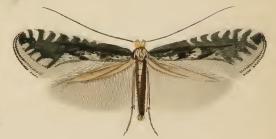
Parornix petiolella is a moth of the family Gracillariidae. It is known from Austria, Bulgaria, the Czech Republic, France, Germany, Hungary, Italy, Kazakhstan, Luxembourg, Moldova, Poland, Romania, the European part of Russia, Slovakia, Switzerland and Ukraine.

The apple blotch leafminer is a moth of the family Gracillariidae. It is known from Canada the United States.

Anthaxia nitidula is a species of jewel beetles belonging to the family Buprestidae, subfamily Buprestinae.
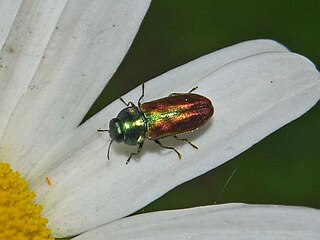
Anthaxia thalassophila is a species of jewel beetles belonging to the family Buprestidae, subfamily Buprestinae.

Blastodacna hellerella is a moth in the family Elachistidae. It is found in most of Europe except the north. In the east, the range extends to the Caucasus.

Anthaxia quadripunctata, the Metallic wood-boring beetle, is a species of jewel beetles belonging to the family Buprestidae, subfamily Buprestinae.
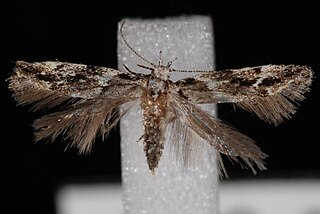
Recurvaria nanella, the lesser bud moth, is a moth of the family Gelechiidae. It is widely distributed in Europe and is also found in Turkey, the Near East, North Africa, the Caucasus, Transcaucasia, Kazakhstan and south-eastern Siberia. It is also found in North America, where it is probably introduced.

The prune plum is a fruit-bearing tree, or its fruit. It is a subspecies of the plum Prunus domestica. The freestone fruit is similar to, but distinct from, the clingstone damson and is especially popular in Central Europe.
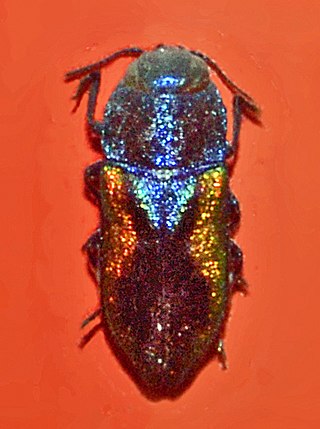
Anthaxia lucens is a species of jewel beetle belonging to the family Buprestidae, subfamily Buprestinae.

Chlorophorus figuratus is a species of round-necked longhorns belonging to the family Cerambycidae, subfamily Cerambycinae.

Orsodacne cerasi is a species of leaf beetle in the family Orsodacnidae.
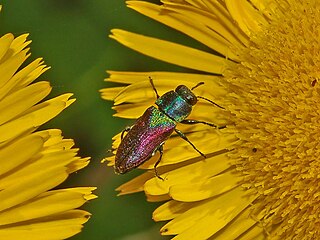
Anthaxia croesus is a species of jewel beetle belonging to the family Buprestidae, subfamily Buprestinae.


















